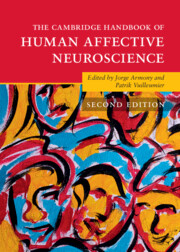Book contents
- The Cambridge Handbook of Human Affective Neuroscience
- Cambridge Handbooks in Psychology
- The Cambridge Handbook of Human Affective Neuroscience
- Copyright page
- Contents
- Figures
- Tables
- Contributors
- Introduction
- Section I Theoretical Models of Emotion
- Section II Measuring Emotional Processes
- Section III Emotion Perception and Elicitation
- Section IV Emotional Learning and Memory
- Chapter 16 Conditioned Fear Learning
- Chapter 17 Reward Learning in a Social World
- Chapter 18 Episodic Emotional Memory
- Section V Cognition–Emotion Interactions
- Section VI Social Emotions
- Section VII Individual Differences
- Index
- References
Chapter 16 - Conditioned Fear Learning
from Section IV - Emotional Learning and Memory
Published online by Cambridge University Press: 16 September 2025
- The Cambridge Handbook of Human Affective Neuroscience
- Cambridge Handbooks in Psychology
- The Cambridge Handbook of Human Affective Neuroscience
- Copyright page
- Contents
- Figures
- Tables
- Contributors
- Introduction
- Section I Theoretical Models of Emotion
- Section II Measuring Emotional Processes
- Section III Emotion Perception and Elicitation
- Section IV Emotional Learning and Memory
- Chapter 16 Conditioned Fear Learning
- Chapter 17 Reward Learning in a Social World
- Chapter 18 Episodic Emotional Memory
- Section V Cognition–Emotion Interactions
- Section VI Social Emotions
- Section VII Individual Differences
- Index
- References
Summary
Pavlovian conditioning paradigms have been a stalwart of animal research on fear learning for over a century. Recent advances in cognitive neuroscience research have led to new insights into the neural mechanisms of how humans learn to associate cues with threats, how these representations become bound to contextual features of the environment, and how they generalize to stimuli that are perceptually or conceptually related. By integrating information gleaned from patients with brain lesions, scalp electrophysiology, neuroimaging, and intracranial recordings, researchers are assembling a dynamic view of the distributed brain activity that generates conditioned fear responses. Innovative virtual reality technology, computational modeling, and multivariate analysis tools have further refined a scientific understanding of the component processes involved, which can inform future clinical interventions for treating fear- and anxiety-related disorders.
Keywords
Information
- Type
- Chapter
- Information
- The Cambridge Handbook of Human Affective Neuroscience , pp. 325 - 345Publisher: Cambridge University PressPrint publication year: 2025
References
Accessibility standard: WCAG 2.0 A
Content Navigation
Allows you to navigate directly to chapters, sections, or non‐text items through a linked table of contents, reducing the need for extensive scrolling.
Provides an interactive index, letting you go straight to where a term or subject appears in the text without manual searching.
Reading Order & Textual Equivalents
You will encounter all content (including footnotes, captions, etc.) in a clear, sequential flow, making it easier to follow with assistive tools like screen readers.
You get concise descriptions (for images, charts, or media clips), ensuring you do not miss crucial information when visual or audio elements are not accessible.
You get more than just short alt text: you have comprehensive text equivalents, transcripts, captions, or audio descriptions for substantial non‐text content, which is especially helpful for complex visuals or multimedia.
Visual Accessibility
You benefit from high‐contrast text, which improves legibility if you have low vision or if you are reading in less‐than‐ideal lighting conditions.
Structural and Technical Features
You gain clarity from ARIA (Accessible Rich Internet Applications) roles and attributes, as they help assistive technologies interpret how each part of the content functions.
